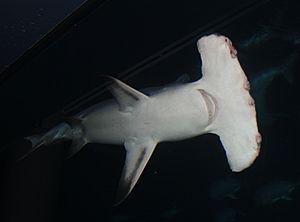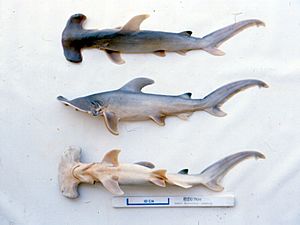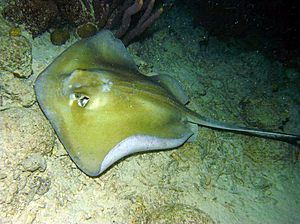Great hammerhead shark facts for kids
Quick facts for kids Great Hammerhead Shark |
|
|---|---|
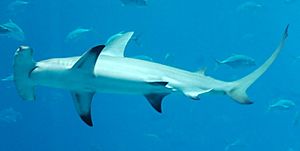 |
|
| Conservation status | |
| Scientific classification | |
| Kingdom: | |
| Phylum: | |
| Class: | |
| Subclass: | |
| Order: | |
| Family: | |
| Genus: | |
| Species: |
S. mokarran
|
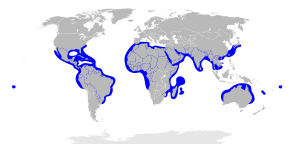 |
|
| Range of the Great Hammerhead Shark (In blue) | |
The Great Hammerhead Shark (Sphyrna mokarran) is the biggest type of Hammerhead shark. You can easily spot it by its unique "hammer-shaped" head, which is called a "cephalofoil." This hammer is wide and has a mostly straight front edge. Also, its first dorsal fin is tall and shaped like a sickle.
Contents
What Does the Great Hammerhead Shark Look Like?
Like all other Hammerhead sharks, the Great Hammerhead Shark has a sleek body. It also has the special "hammer" on its head. People sometimes confuse them with the Scalloped Hammerhead Shark or the Smooth Hammerhead Shark. But adult Great Hammerheads are different. Their wide cephalofoil has a very straight front edge. Their first dorsal fin is also tall and curved like a sickle. This "hammer" part of their head is usually about 1 to 1.5 meters (3 to 5 feet) wide.
Great Hammerhead Sharks are usually about 2.85 to 5.5 meters (9 to 18 feet) long. They can weigh around 450 kilograms (990 pounds). The longest one ever found was 6.1 meters (20 feet) long. The heaviest was a female, 4.4 meters (14.4 feet) long, weighing 580 kilograms (1,280 pounds). She was caught off Boca Grande, Florida, and was pregnant. The top part of a Great Hammerhead Shark is grey-brown or green. Their belly is white.
Where Do Great Hammerhead Sharks Live?
The Great Hammerhead Shark lives in warm, tropical waters around the world. You can find them between 40°N and 37°S latitudes. In the Atlantic Ocean, they live from North Carolina to Uruduay. This includes the Gulf of Mexico and the Caribbean Sea. They are also found from Morocco to Senegal and in the Mediterranean Sea.
They live all around the edge of the Indian Ocean. In the Pacific Ocean, they are found from the Ryukyu Islands to Australia. They also live near New Caledonia and French Polynesia. You can also find them from southern Baja California to Peru. Great Hammerhead Sharks can live in shallow waters, less than 1 meter (3 feet) deep. They also live in deeper offshore waters, up to 80 meters (260 feet) deep. They mostly live near coral reefs. However, they have also been seen in lagoons and deep water close to land.
How Do Great Hammerhead Sharks Behave?
Great Hammerhead Sharks are apex predators, meaning they are at the top of their food chain. However, young pups have been seen eaten by Bull sharks. Smaller fish like Yellow jacks sometimes rub themselves against Great Hammerhead Sharks. They probably do this to get rid of parasites. Pilot fish are also often seen swimming alongside Great Hammerhead Sharks.
Great Hammerhead Shark Reproduction and Life Cycle
Great Hammerhead Sharks are viviparous. This means they give birth to live young, just like mammals. Female sharks are pregnant for about 11 months. After this, they give birth to a group of 6 to 56 pups. When they are born, the pups are about 50–70 centimeters (20 to 28 inches) long.
Male Great Hammerheads become adults when they are about 2.3 to 2.8 meters (7.5 to 9 feet) long. They weigh around 51 kilograms (112 pounds). Females become adults when they are about 2.5 to 3 meters (8 to 10 feet) long. They weigh around 41 kilograms (90 pounds). Great Hammerhead Sharks usually live for about 20–30 years. However, the oldest one ever found was thought to be 40–50 years old.
What Do Great Hammerhead Sharks Eat?
Great Hammerhead Sharks are known to hunt during dawn and dusk. They eat many different things. Their diet includes crustaceans like crabs and lobsters. They also eat molluscs such as squids and octopuses. They hunt bony fish like tarpon, sardines, and herrings. Other fish they eat include sea catfish, toadfish, porgies, jacks, croakers, groupers, flatfish, boxfish, and porcupine fish. They even eat other sharks, like smoothhounds and grey reef sharks. Sometimes, Great Hammerhead Sharks have been known to eat other sharks of their own kind.
Their favorite food is rays and skates, especially stingrays. The venomous spines of stingrays do not seem to hurt them. One Great Hammerhead Shark caught off Florida had 96 venomous spines in and around its mouth!
The "hammer" on their head is thought to be used to pin down stingrays. One Great Hammerhead Shark was seen attacking a southern stingray in the Bahamas. The shark first hit the stingray with its hammer to pin it down. Then, it grabbed the stingray in its jaws. It ripped the stingray apart by shaking its head very fast. Another Great Hammerhead Shark was seen attacking a spotted eagle ray in the open ocean. First, the shark bit off one of the ray's pectoral fins. Then, it pinned the ray down with its hammer and ate the ray head-first.
How Do Great Hammerhead Sharks Interact with Humans?
Even though some people think they are dangerous, Great Hammerhead Sharks rarely attack humans. Divers who have seen them say that Great Hammerhead Sharks are shy. They usually try to avoid people.
Why Are Great Hammerhead Sharks Endangered?
This shark species is listed as globally critically endangered on the IUCN Red List. This means they are at a very high risk of becoming extinct. In the northwestern Atlantic and the Gulf of Mexico, their numbers have dropped by 50% since the 1990s. This is mostly because they are accidentally caught by fishing boats. This is called "bycatch."
They are also endangered in the southwestern Indian Ocean. Many fishing boats operate illegally there, catching hammerheads. The number of Great Hammerheads caught in the Indian Ocean fell by 73% from 1978 to 2003. Along the western coast of Africa, their numbers have crashed. There has been an estimated 80% decline in the last 25 years. Fishing continues there without being watched or controlled.
No special rules or laws have been made just to protect the Great Hammerhead. However, some countries and groups, like the United States and the European Union, have banned shark finning. This means sharks cannot be caught just for their fins. This should help reduce the pressure on Great Hammerhead Sharks.
A study in January 2021, published in the journal Nature, looked at 31 species of sharks and rays. It found that the number of these species in open oceans had dropped by 71% in about 50 years. The Great Hammerhead was one of the species included in this study.
Images for kids
See also
 In Spanish: Tiburón martillo gigante para niños
In Spanish: Tiburón martillo gigante para niños



